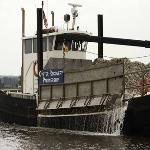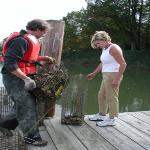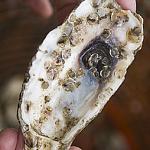22 November 2010

Photo: Erika Nortemann/? 2010 The Natur
The Oyster Recovery Program plants more than two billion hatchery oysters in state sanctuary waters.
In 2008, on a private pier on the Tred Avon River, Maryland Gov. Martin O'Malley kicked off an effort to get property owners along state rivers to become caretakers for oysters. The Marylanders Grow Oysters program began with 250 families and has expanded to 2,000 growers on 18 rivers.
Oysters were once plentiful here but no more. Generations of overfishing, a decline in water quality, disease and polluted urban and agricultural runoff have decimated its population.
Recovery effort
Chris Judy, with the Maryland Department of Natural Resources, oversees the program, which is part of a larger recovery effort for the Chesapeake Bay, the nation's largest estuary. On this day, the shellfish biologist heads off the Tred Avon into Trippe Creek where Sally Ackridge tends 34 oyster cages on three piers.

Oxford, Maryland Library
In the 1880s, Chesapeake Bay watermen hauled in 15 million bushels of oysters to meet national demand.
Before he loads her trove for the season he points out the tiny blister like pumps on each shell. These are the spat or baby oysters that over the next nine months will grow into clumps. "The cluster of oysters on the bottom [is] habitat to different types of fish and crab and worms," Judy says.
Oysters are the foundation for a healthy ecosystem. They clean the water by eating algae and nutrients that pollute the Chesapeake Bay.
Ackridge says caring for this brood is fairly simple. "We just come out every week or two and shake the baskets."
That action removes sediment and aquatic vegetation and makes the hanging baskets easier to handle as the oysters grow. She adds the work is also a valuable lesson. "I think that we're going to show the next generation, our children and grandchildren that we need to be participants in nature."
Judy also brings new stock to Marilyn Engle, a marine scientist, who has been an oyster grower for three years. "I knew that oysters help water quality, and I've been happy about the program. I think that it's important that people become involved and as they do, it's an education. I love being here on the Eastern Shore, and I want to help take care of it!"

VOA - R. Skirble
Chris Judy with Sally Ackridge on her backyard pier where she cares for 38 cages of baby oysters.
Rehabilitating oyster bars
After the drop-offs, Judy motors to a marine sanctuary. Maryland has rehabilitated more than 500 hectares of once viable oyster bars.
This is where the home-grown oysters are planted, along with 2.5 billion oyster spat that come directly from the state oyster hatchery. While homeowners only grow a couple of million by comparison each year, a much higher percent of the nurtured oysters survive.
And, besides, Judy says his growers raise awareness among the public about the watershed. "The program is really about education, outreach, motivation and enhancement. Sanctuaries are specifically enhanced with these oysters. They are improved. The bottom is made better. There are more live oysters. The growers can be confident that they are making a difference in their local sanctuary."

Erika Nortemann Photography
Those tiny pimple like bumps on the shell mature into oyster clumps and are planted in a marine sanctuary to live out their lives undisturbed.
Considering the size of the Chesapeake Bay which sprawls through six states and Washington, DC, Judy says, much more needs to be done. The Marylanders Grow Oysters program is part of a larger coordinated recovery strategy, including research, monitoring and public programs Judy says the end game is the same to jump start Mother Nature.
"The sanctuary must serve as breeding site," he says. "That's the ultimate goal. What we hope to see is the oysters spawn and those larvae then settle somewhere and create new oysters through the natural process of reproduction."
Judy says Maryland oyster growers are making those steps toward natural recovery, one cage at a time.